|
History
The Basilica symbolises so much - it's Byzantine to show Venice's
links with the East, it houses the remains of Saint Mark, but is very much
the shrine of the republic, having been built as the Doge's private chapel. It
wasn't built as a cathedral and its dean and clergy were all appointed by
the Signoria and so chosen by the government - so typical of Venice anti-papal
tradition.
The first church built here was dedicated to Saint Theodore, Venice's first
patron saint, who came appropriately from Constantinople. In 829, at the instructions of Doge Justinian Partecipacius,
a chapel enlarging the church was built to also house the remains of Saint Mark the Evangelist
- see
Acquiring Saint Mark's relics
below.
Consecrated in 832, nothing remains of this church, which was damaged in the
fires that raged during the revolt against Doge Pietro IV Candiano in 976
and rebuilt by Doge Pietro Orseolo. We know nothing for certain of the appearance of these
churches, despite much conjecture and some archaeological research. The second church stood for
80 years
before it too was replaced, by the current building, probably begun in 1063
by Doge Domenico Contarini and
consecrated in 1094 by Doge Vitale Falier. Much decorated in later
centuries, the current
structure is substantially this 11th century church, although it was much simpler and
more severe in appearance initially. Its shape and design is said to have
been based on the long-lost church of the Holy Apostles in Constantinople
and to have been the work of Greek architects.
It was originally faced with
brick, with most of the marble cladding, friezes and statues that we see
today, including the four famous horses, nearly all plunder from the
4th Crusade's capture and pillage of Constantinople in 1204, added during the first half of the 13th
century. These embellishments give it some of the ancient-art credibility
lacking in a city with no roman past. It functioned initially as a martyrium for
Saint Mark and a palace chapel for the doges, central to
ceremonial Venice. Only later did it take over from
San Pietro di Castello
as the cathedral of Venice, a move enforced by Napoleon in 1807,
thereby putting an end to its ducal-ceremonial function.
The church
The cycle of mosaics on the famous façade facing Piazza San
Marco read from right to left, as the main approach until relatively
recently was always from the lagoon and the façade facing south was then
the first sight of the church, and therefore had greater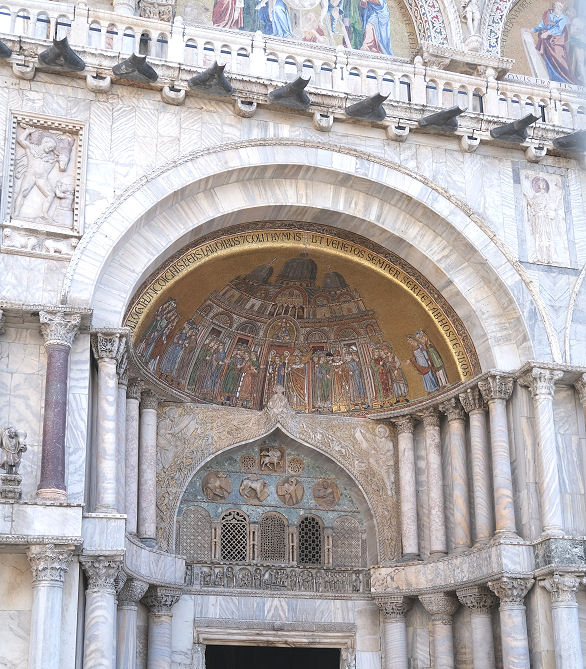 importance and impact. The upper level pinnacles and mosaics date from the
15th and 17th centuries respectively. The façade still has a pretty
triumphal aspect despite this later building, including the Gothic upper
arches, detracting from the Byzantine charm somewhat. Of the five mosaics in the
arches only the one over the first door on the left is an original from
the 13th century (see right), the rest being replacements made from the 17th to the
19th centuries. Being the last in the sequence this left-hand mosaic is of
the body of Saint Mark being taken into the Basilica, and shows the façade
as it looked in around 1250. The north façade, onto the Piazzetta dei Leoncini, is a mess of
bits, impressive in parts but not exactly harmoniously combined, although
looking pretty handsome after a recent clean.
importance and impact. The upper level pinnacles and mosaics date from the
15th and 17th centuries respectively. The façade still has a pretty
triumphal aspect despite this later building, including the Gothic upper
arches, detracting from the Byzantine charm somewhat. Of the five mosaics in the
arches only the one over the first door on the left is an original from
the 13th century (see right), the rest being replacements made from the 17th to the
19th centuries. Being the last in the sequence this left-hand mosaic is of
the body of Saint Mark being taken into the Basilica, and shows the façade
as it looked in around 1250. The north façade, onto the Piazzetta dei Leoncini, is a mess of
bits, impressive in parts but not exactly harmoniously combined, although
looking pretty handsome after a recent clean.
Interior
The narthex you cross as soon as you enter stretches across the
width of the façade and a right-angled branch to the left goes up to the
transept. The mosaics in the cupolas of the branch include three depicting
the life of Joseph, an Old Testament figure said to prefigure Saint
Mark. The church is Greek cross shaped with a central dome and a dome
in each of the four square bays, these aisled bays meeting in a crossing dominated by huge piers pierced with passages.
It was just as
overwhelming on first entering as it was on my last visit, 15 years ago,
but the plan is less confusing than I remember.
Everything glows, every
surface is richly decorated with marble of mosaic and almost every vista has a Piranesi-like queasy
complexity. Inside
your progress is roped-off and guided, with nowhere to sit. The no photo
rule applies but is patchily enforced. The interior is
unquestionably Byzantine- influenced - the now-lost Church of the Twelve
Apostles in Constantinople, built by the Emperor Justinian in the 6th
century is often cited as a model - but the altar
being in the presbytery and the presbytery being raised to accommodate the
crypt help make the interior much more Italian. You pay
€2 to
get into this
presbytery and see the Pala d'Oro (behind the altarpiece)
sparklingly lit but behind glass. Saint Mark's sarcophagus is under the
altar.
You pay €3 for
the Treasury, which consists of two rooms. On the left after
paying is a small sanctuary full of reliquaries and saint's bits. Much better
is the room opposite, the actual Treasury in an impressive square and
domed space with some lovely icons and glassware. I found the treasury
inessential but the museum (€5) up a steep staircase to the right of the
entrance to the basilica, is a real treat. Mosaic fragments, up-close views of
mosaics in the left transept, the horses, models and plans, and the view
from the outside terrace, make this a bargain ticket. And there's
the new Sala dei Banchetti, housing mostly tapestries, but also
Paolo Veneziano's cover for the Pala d'Oro mentioned below, and cases of graduals.
The campanile
The first bell tower was built in the 9th century and has been enlarged,
restored and repaired many times since.
The mosaics
It seems likely that the second St Marks, built after the fire of 976,
would have been decorated with mosaics. The mosaic work in the apse of
Santa Maria Assunta on Torcello dates to around the same time as the
current basilica was built.
The earliest mosaics here are the four
saints in niches either side of the door. They are probably late-11th-century - the standing figures in the main apse and the prophets of the
earlier work in the presbytery dome date to the early-12th. On the domes
and vaults in the narthex are scenes from the Old Testament. Inside are
saints and New Testament scenes like the Pentecost and the
Ascension.
The degree to
which the devastating fire which swept Venice in 1106 destroyed earlier
mosaics and/or necessitated their replacements is much argued. Work
continued here into the late 12th century, undoubtedly the most important
century for the interior mosaics, as did the work in the apse and
on the huge Last Judgement on Torcello. It is thought that craftsmen
brought from Byzantium were responsible, at least initially, before locals
learnt from them and continued. Possibly. Later centuries saw the need
for, and the carrying out of, considerable repairs. Paolo Uccello and
Andrea del Castagno were amongst the artists called in to repair and train.
Later interventions were more likely to replace old and 'ugly' mosaics
with new works. The worst offenders here were Titian, Veronese, Tintoretto, Salviati
and Palma Giovane. The new Apocalypse mosaic at the west end of the
nave was one of these additions. Only in 1610 was a decree issued stopping this
practice, as the old works had often been said to have been better than
the new. This decree had to be repeated several times so may not have been
very effective. As the skill and number of mosaicists declined, the rock
bottom was reached in the 19th century, with repairs and materials of
particularly poor quality.
Some 110 scenes in the mosaics in the atrium are said to be derived from miniatures
in the Cotton Genesis, a 6th-century Greek manuscript (now in the British Library) taken
from Constantinople. Or Alexandria - expert opinions differ.
The Pala d'Oro
Much added to, the Pal d'Oro
(see photo right) is made of gold and silver and now has 187
enamel plaques and almost 2000 gems. It was originally an antependium
(altar frontal) made for Doge Pietro Orseolo in 976, remade and placed at
the back of the altar in 1105. Then remade again in 1209 and 1345. The original
bottom section shows scenes from the Life of St Mark - these were
originally along the very bottom but now go along the top and down the
sides of the central section. The main central section has Christ in the
centre, with the Four Evangelists in circular panels and flanking rows of
the Apostles, with angels above and the twelve prophets below.
The 1209 'renewal' saw the addition along the top of
the seven larger panels looted from Constantinople. Here six panels of
scenes from the Gospels flank the Archangel Michael. These enamel panels
probably came from the church of the monastery of the Pantocrator in Constantinople. Some form
of Byzantine imperial involvement is suggested by one of the early 12th
Century enamel panels depicting Empress Irene - a balancing panel of her
husband Emperor Alexios I was removed at a later date. She is now balanced
by a panel of Angelo Falier, procurator during the enlargement of 1209. The 1345 work saw the goldsmith Giovanni Paolo
Benesegna commissioned to make a gothic frame and add more precious
stones.
In 1432/4 Paolo Veneziano was commissioned to paint a wooden cover
for the Pala d'Oro which was only displayed on the feast days of the
Nativity and Easter, being hoisted up on those days by a system of pulleys. This cover (see
photo right) which became known as the Pala Feriale, or
“weekday altarpiece”, was painted by Paolo with the help of his sons Luca
and Giovanni - all three signed the work, dated 1345. The original framing
elements are lost so Paolo's panels are presented now in two rows.
On the top row The Man of Sorrows is flanked on the left by the
Virgin, Saints Theodore and Mark, and on the right by Saints John the Evangelist, Peter, and
Nicholas of Myra. Scenes of the life of Saint Mark and the theft of
his relics are in the row below. In the 15th century this cover
was replaced with
a plain wooden panel and the Venezianos' panels are now displayed in the
San Marco Museum.
The 4th Crusade spoils
The 4th crusade set out in 1402 to wrest control of Holy Christian sites
back from the infidel, but more famously resulted in the invasion and
sacking of Christian Constantinople in what began with a request to sort
out a succession crisis and ended up in murder and pillage. It was to
prove the beginning of the end for the great empire, but was arguably
retaliation for the pogrom-like Massacre of the Latins which had seen the
slaughter of Catholics, men. women and children, mostly from Venice, Genoa
and Pisa, during the reign of Emperor Alexios II Komenenos decades
previously. 4,000 of those who survived had then been sold as slaves to
the Seljuk Turks.
The four gilded bronze horses, probably
spoils taken to Constantinople in the 4th-6th century, were removed from the Hippodrome
there,
presumably, or nearby, and set up over the main entrance here in the 1254.
Venice having no Roman past itself, the horses would've been seen as a
suitably symbolic indicator of Venice's ambition to be the new Rome. They
are actually made of copper, with a little (c.2%) tin, so are not strictly
bronze. The date of their creation has been previously said to be anything
from 400BC to 400AD, but is now narrowed to after the 2nd century AD, due
to the difficulty of casting copper and the use of mercury gilding making
an earlier date unlikely. Napoleon
took them to Paris in 1797, where they ended up on top of the Arc de Triomphe du Carrousel in the Tuilleries, until they were returned to Venice in 1815
following the defeat of Napoleon. They
were moved indoors
to protect them from acid rain and replaced by copies in the
1970s.
The Tetrarchs - a porphyry sculpture of
the then four rulers of the Roman Empire, of around 300 (see right)
possibly taken from the Philadelphion in Constantinople. They are probably
the bearded emperors Diocletion and Maximilian and the clean-shaven
Caesars Galerius and Constantius I. In Francesco Sansovino's
Guidebook to Venice of 1561 he tells a story of four merchants who
smuggled treasures into Venice, but deciding that the proceeds would have
to be split too many ways a pair decided to poison the other two, with the
other two having the same idea, so all four were poisoned. He reports that
'in the opinion of the mob' these four are the figures depicted in
the Tetrarchs sculpture, but admits that it is just a fable. The
missing heel and plinth fragment was found in Istanbul in the 1960s and is
now in the Archeology Museum there.
Marble revetments, floors, columns (and their bases
and capitals) and panels of sculpture, stripped from the churches of
Constantinople. Mostly their origins are untraceable, but capitals and
columns from the 6th-century church of Saint Polyeuktos are distinctive, like
the misnamed pilastro acritani.
Acquiring Saint Mark's relics
Saint Mark had been the Bishop of nearby
Aquileia, where he had been sent by Saint Peter. On his way,
in his boat, passing near where Venice was to be built, he had a vision
telling him that his body would find its final resting place nearby. He
was martyred in Alexandria, his next posting, in 68AD.
Around 828 some Venetian merchants travelled to Alexandria intending
to 'acquire' the relics of Saint Mark. Two of their number, Buono da
Malamocco and Rustico da Torcello. learnt from the custodians of the
sanctuary where the saints bones were kept that they were in danger of
being destroyed by the Arab governor of Alexandria who was going to
use marble and columns from Christian churches to build himself a palace
in the city of Babylon. Or so the story goes. The custodians having been talked around, the
saint's remains were replaced by the nearby body of Saint Claudia and the relics
loaded aboard ship, hidden in wicker baskets and covered with cabbage
leaves and pork, the latter considered unclean by Muslims. So when customs
men came to inspect the cargo their disgust made them wave the baskets
through without inspection.
On the voyage back to Venice the saint appeared to the dozing sailors and saved
them from shipwreck. The relics were initially
placed in a corner of the Ducal Palace awaiting the building of the new
basilica. Saint Mark thereby became the patron saint of
Venice, replacing Saint Theodore. In 976 the relics were lost in a fire. Only at a reconsecration in 1094
did the the
saint himself reveal the location of his remains to Doge Vitale Falier and the
people gathered in the basilica, by extending an arm from a pier on the right hand side
of the nave. The church was
also filled
with a sweet smell.
Other relics
The relics housed here have included an arm of Saint George, a
stool which belonged to the Virgin, a finger of Mary Magdalene, a knife
used at the last supper, the stone on which John the Baptist was beheaded,
a rib of Saint Stephen, and the sword Saint Peter used to cut off
Malchus's right ear. The latter, a servant of Caiaphas, being one of those
attempting to arrest Jesus.
Lost art
There is a 12th century mosaic fragment of a male head, a
personification of Mesopotamia, removed from the west dome here, in the
Victoria & Albert Museum in London. It was removed by the restorers
Salviati in 1867.
The Basilica in art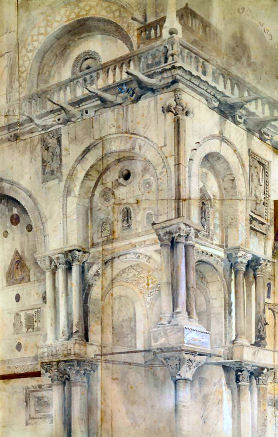
There are countless views of the Piazza which feature the
Basilica. Gentile Bellini's
Procession of the True Cross in Piazza San Marco of 1496 (see
right) was
painted for the Grand Hall of the
Scuola Grande di San Giovanni
Evangelista but is now in the Accademia. It shows us how the
Basilica looked in the late 15th century, with its original lunette
mosaics. Three paintings by Canaletto of the interior during Easter
celebrations exist - two in the British Royal Collection and one in
Montreal. John Ruskin made many fine sketches of details (see right).
There are lots by Sickert.
Dickens wrote (in
Pictures from Italy)
A grand and dreamy structure,
of immense proportions; golden with old mosaics; redolent of perfumes; dim
with the smoke of incense; costly in treasure of precious stones and
metals, glittering through iron bars; holy with the bodies of deceased
saints; rainbow-hued with windows of stained glass; dark with carved woods
and coloured marbles; obscure in its vast heights, and lengthened
distances; shining with silver lamps and winking lights; unreal,
fantastic, solemn, inconceivable throughout.
Opening times
October – March/April (Easter):
Basilica: 9.30 - 5.00 (last admission 4.45)
Sunday and holidays:
2.00 - 4.00 (entrance free)
St. Mark’s Museum: 9.45– 4.45 €5
Pala d’Oro: 9.45 - 4.00 Sunday and holidays: 2.00 - 4.00 €2
Treasury: 9.45 - 4.00 Sunday and holidays: 2.00 - 4.00 €3
March/April (Easter) – November:
Basilica: 9.45 - 5.00 (last admission 4.45) Sunday and holidays: 2.00 -
5.00 (entrance free)
St. Mark’s Museum: 9.45 - 4.45 €5
Pala d’Oro: 9.45 - 5.00 Sunday and holidays: 2.00 - 5.00 €2
Treasury: 9.45- 5.00 Sunday and holidays: 2.00 - 5.00 €3
website
Vaporetto Vallaresso (San Marco)
map
|
|
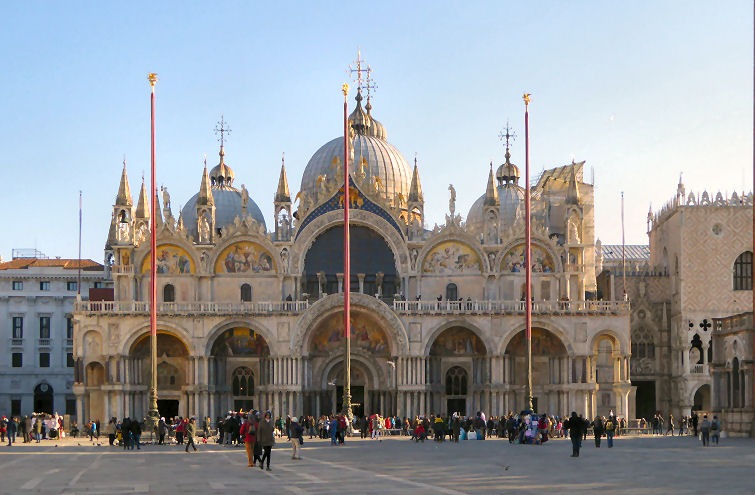
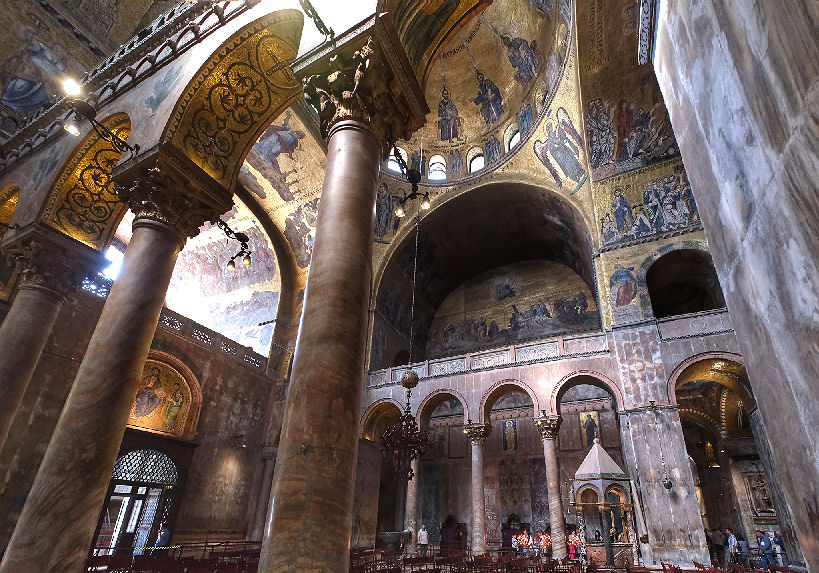
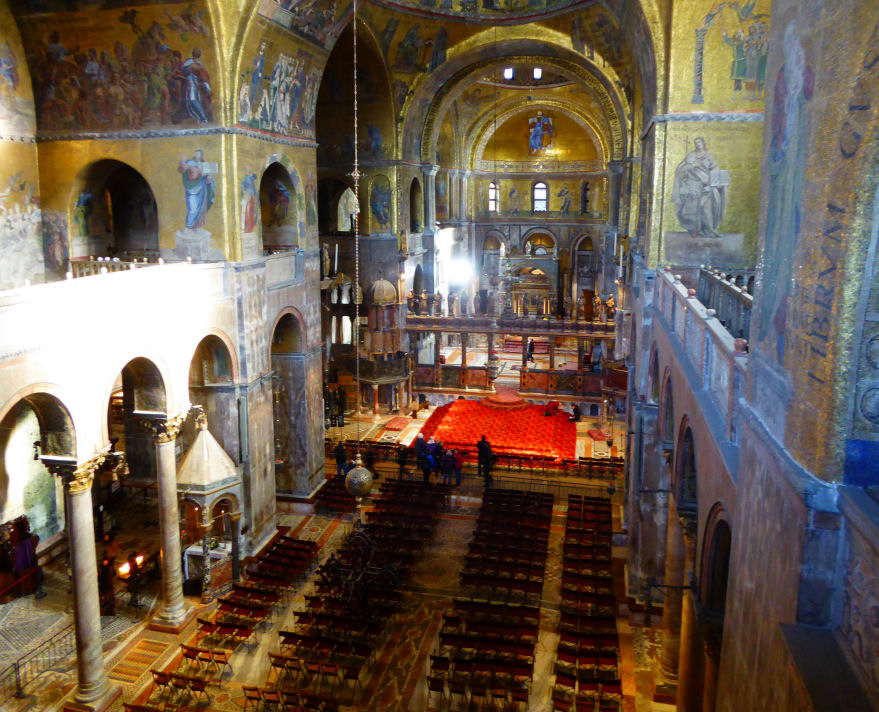
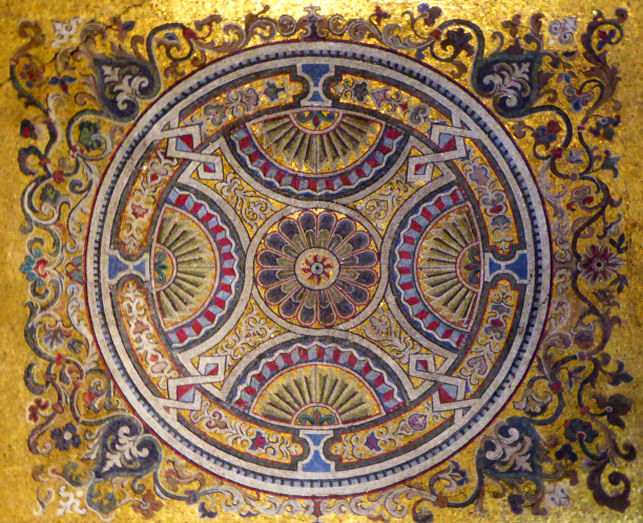
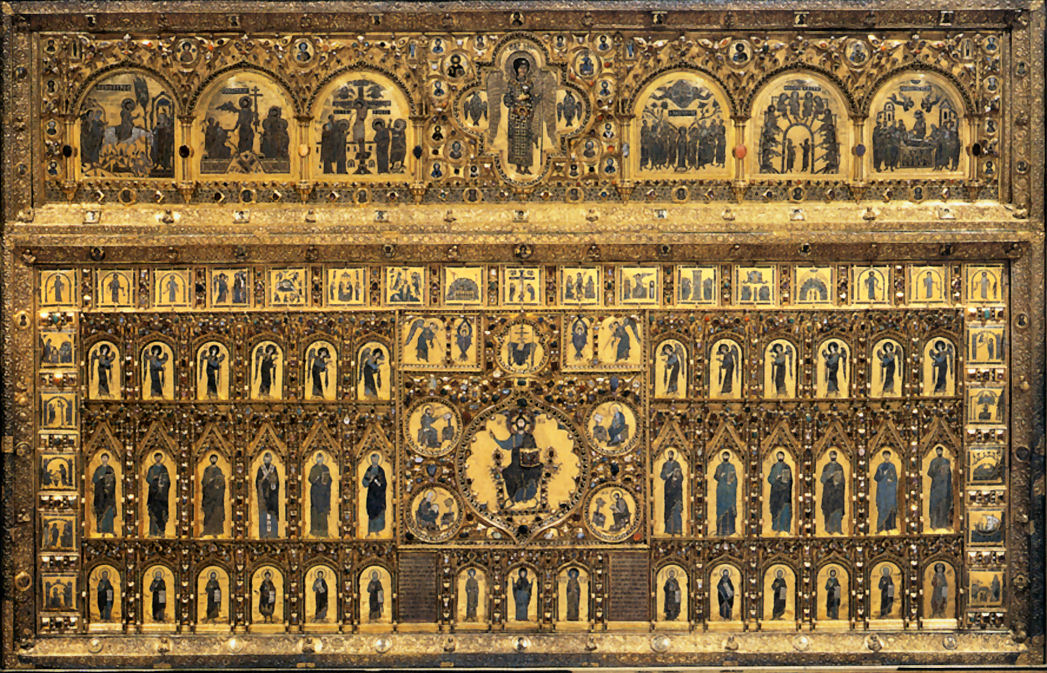
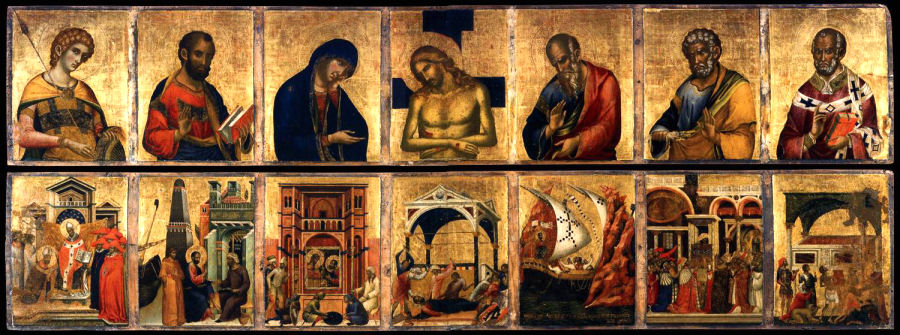
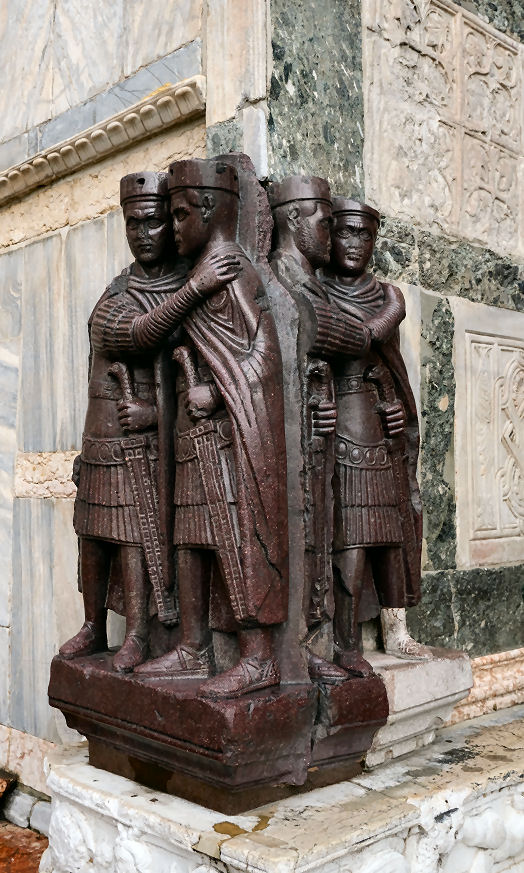
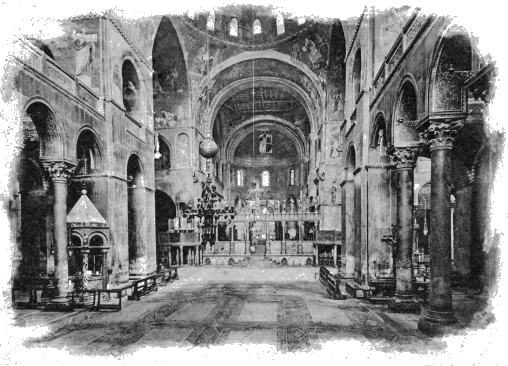
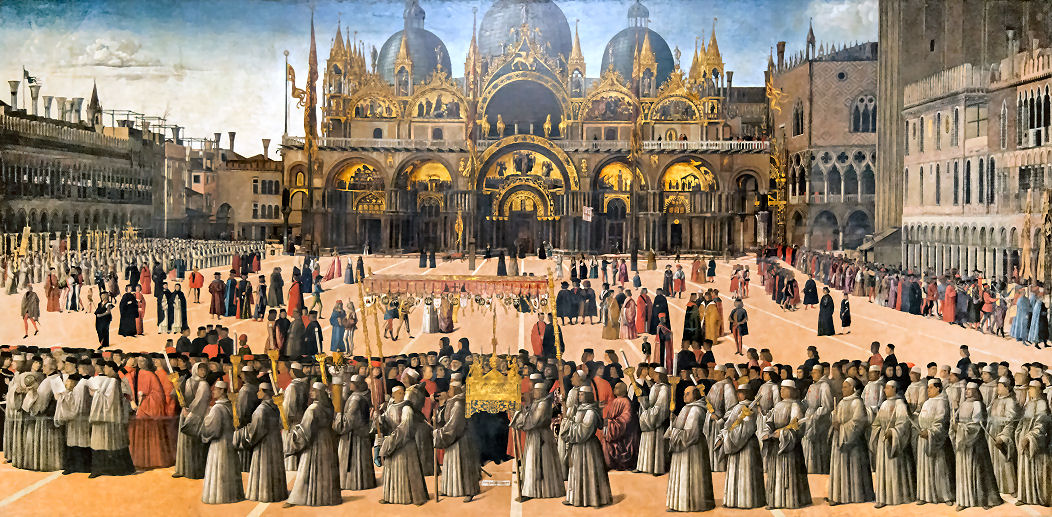
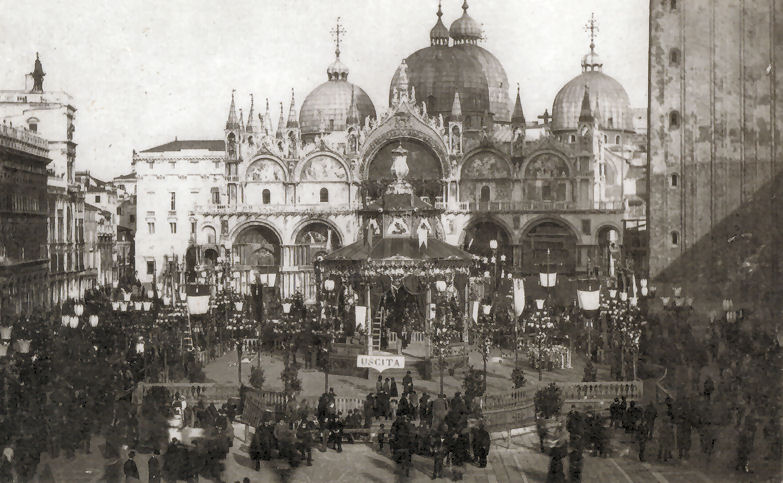
San Teodoro
Only in 2024 have I
found out about this church.
The small church of San Teodoro is to be found now within the San Marco
Basilica complex. A church dedicated to Venice's earliest patron saint
seems to have existed by the 8th century in the current Piazzetta dei
Leoncini. It was a simple with an aisle and two naves, a front narthex and
a semicircular apse. An earlier and smaller church dedicated to Saint Mark
sat between this church of San Teodoro from the first Palazzo Ducale. This
first church of San Teodoro was demolished in the 12th century during the
construction of the current basilica of San Marco
A new church was built beyond the apse-end of the Basilica. This was a in
a Renaissance-style and designed by Giorgio Spavento. Work began in 1486
under the guidance of Maestro Domenico and was completed within only a few
years. The façade originally had frescoes by Tommaso di Giorgio, but these
are long lost. Part of the building is now within the structure of the
Palazzo Ducale overlooking the Rio di Palazzo. The building has been used
as a seat of the Inquisition and later as a sacristy. Restoration work
took place in 1961.
The façade is bare brick. Over the entrance portal is a lunette painting
from 1490 by Sebastiano da Lugano and Matteo da Valle. The only art
reported inside is a Nativity, an early work by Giambattista
Tiepolo.
|